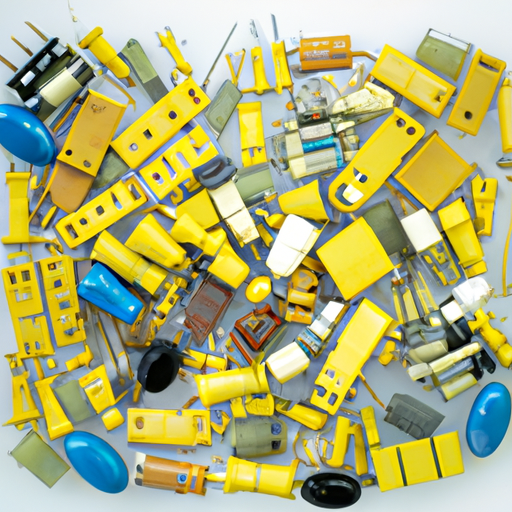What Components and Modules Does Resistor Recycling Consist Of?
I. Introduction
In an age where electronic devices are ubiquitous, the issue of electronic waste (e-waste) has become increasingly pressing. Among the various components that make up electronic devices, resistors play a crucial role in circuit functionality. However, as technology evolves and devices become obsolete, the need for effective resistor recycling has emerged as a vital aspect of e-waste management. This article will explore the components and modules involved in resistor recycling, highlighting its importance in promoting sustainability and resource recovery.
II. Understanding Resistors
A. Definition and Function of Resistors in Electronic Circuits
Resistors are passive electronic components that limit the flow of electric current in a circuit. They are essential for controlling voltage and current levels, ensuring that other components operate within their specified limits. By providing resistance, they help to manage power distribution and protect sensitive components from damage.
B. Types of Resistors Commonly Used in Electronics
1. **Fixed Resistors**: These resistors have a constant resistance value and are widely used in various applications, from simple circuits to complex electronic devices.
2. **Variable Resistors (Potentiometers)**: These allow users to adjust resistance levels, making them ideal for applications like volume controls in audio equipment.
3. **Specialty Resistors**: This category includes thermistors, which change resistance with temperature, and photoresistors, which vary resistance based on light exposure. These resistors are crucial in sensors and other specialized applications.
C. Materials Used in Resistor Construction
Resistors can be made from various materials, each offering different properties:
1. **Carbon Composition**: These resistors are made from a mixture of carbon and a binding material, providing a cost-effective solution for many applications.
2. **Metal Film**: Known for their precision and stability, metal film resistors are often used in high-performance circuits.
3. **Wire-Wound**: These resistors are constructed by winding a wire around a core, offering high power ratings and precision.
4. **Thick and Thin Film**: These resistors are made by depositing a resistive film onto a substrate, allowing for compact designs and precise resistance values.
III. The Need for Resistor Recycling
A. Environmental Impact of Electronic Waste
The rapid advancement of technology has led to an increase in electronic waste, which poses significant environmental challenges. Resistors, like many electronic components, can contain hazardous materials that, if not disposed of properly, can leach into the environment, causing soil and water contamination.
B. Resource Recovery and Sustainability
Recycling resistors contributes to resource recovery by reclaiming valuable materials such as metals and plastics. This process not only reduces the demand for virgin materials but also minimizes the energy consumption associated with manufacturing new components.
C. Economic Benefits of Recycling Resistors
The economic advantages of resistor recycling are substantial. By recovering valuable materials, companies can reduce production costs and create new revenue streams. Additionally, recycling initiatives can generate jobs and stimulate local economies.
IV. Components of Resistor Recycling
A. Collection and Sorting
1. **Collection Methods**: Resistor recycling begins with the collection of e-waste. This can occur through drop-off centers, e-waste drives, or collection bins placed in strategic locations. Public awareness campaigns are essential to encourage participation in these programs.
2. **Sorting Processes**: Once collected, resistors must be sorted from other electronic components. This can be done manually or through automated systems that use advanced technologies to identify and separate resistors based on their type and material composition.
B. Dismantling
1. **Tools and Equipment Used in Dismantling**: Dismantling involves breaking down electronic devices to access the resistors. This process requires specialized tools such as soldering irons, pliers, and safety equipment to ensure the safety of workers.
2. **Safety Measures During Dismantling**: Given the potential hazards associated with e-waste, safety measures are crucial. Workers should be trained in handling hazardous materials and provided with personal protective equipment (PPE) to minimize risks.
C. Material Recovery
1. **Separation of Materials**: After dismantling, the next step is to separate the materials. This involves categorizing resistors based on their construction materials, such as metals, plastics, and ceramics.
2. **Processes for Recovering Valuable Materials**:
a. **Metal Recovery**: Metals like copper and aluminum can be extracted from resistors and other electronic components. These metals can then be refined and reused in new products.
b. **Plastic Recycling**: The plastic casings of resistors can be processed and repurposed for various applications, reducing the need for new plastic production.
c. **Ceramic Recycling**: Ceramic materials used in certain types of resistors can also be recycled, contributing to the overall sustainability of the recycling process.
D. Waste Management
1. **Disposal of Non-Recyclable Components**: Not all components can be recycled. Non-recyclable materials must be disposed of responsibly, following local regulations to prevent environmental harm.
2. **Compliance with Environmental Regulations**: Recycling facilities must adhere to strict environmental regulations to ensure that their processes do not contribute to pollution or other environmental issues.
V. Modules Involved in Resistor Recycling
A. Recycling Facilities
1. **Overview of Recycling Plants**: Recycling facilities are equipped to handle the various stages of the recycling process, from collection to material recovery. These plants are designed to maximize efficiency and minimize environmental impact.
2. **Technology and Machinery Used in Recycling**: Advanced technologies, such as automated sorting systems and shredders, are employed to streamline the recycling process and improve material recovery rates.
B. Transportation and Logistics
1. **Role of Logistics in the Recycling Process**: Efficient transportation and logistics are critical for the success of resistor recycling. This includes the movement of e-waste from collection points to recycling facilities.
2. **Challenges in Transporting Electronic Waste**: Transporting e-waste can pose challenges, including regulatory compliance, safety concerns, and the need for specialized vehicles to handle hazardous materials.
C. Quality Control
1. **Ensuring the Quality of Recycled Materials**: Quality control measures are essential to ensure that the recycled materials meet industry standards. This involves testing and analyzing materials to verify their composition and purity.
2. **Testing and Certification Processes**: Recycled materials may require certification to ensure they are suitable for use in new products. This process helps maintain consumer confidence in recycled materials.
D. Research and Development
1. **Innovations in Resistor Recycling Technology**: Ongoing research and development efforts are focused on improving recycling technologies and processes. Innovations may include new methods for material recovery and enhanced sorting technologies.
2. **Future Trends in Recycling Processes**: As the demand for sustainable practices grows, the recycling industry is likely to see increased investment in advanced technologies and processes that improve efficiency and reduce environmental impact.
VI. Case Studies and Examples
A. Successful Resistor Recycling Programs
Several organizations and municipalities have implemented successful resistor recycling programs. These initiatives often involve partnerships with local businesses and educational institutions to raise awareness and promote participation.
B. Companies Leading the Way in Electronic Waste Recycling
Companies such as Dell, HP, and Apple have established comprehensive recycling programs that include resistor recycling. These companies not only focus on recovering materials but also emphasize sustainability in their manufacturing processes.
C. Lessons Learned from Existing Recycling Initiatives
Successful recycling initiatives provide valuable insights into best practices, including the importance of community engagement, effective logistics, and the need for continuous improvement in recycling technologies.
VII. Conclusion
Resistor recycling is a critical component of electronic waste management, offering significant environmental, economic, and social benefits. By understanding the components and modules involved in this process, individuals and businesses can contribute to a more sustainable future. As technology continues to evolve, the importance of resistor recycling will only grow, making it essential for all stakeholders to take action. Whether through participation in recycling programs or advocating for sustainable practices, everyone has a role to play in promoting responsible e-waste management.
VIII. References
A comprehensive list of studies, articles, and resources related to resistor recycling and electronic waste management can be found in the references section. For those interested in further exploration, additional reading materials are available to deepen understanding of this vital topic.
What Components and Modules Does Resistor Recycling Consist Of?
I. Introduction
In an age where electronic devices are ubiquitous, the issue of electronic waste (e-waste) has become increasingly pressing. Among the various components that make up electronic devices, resistors play a crucial role in circuit functionality. However, as technology evolves and devices become obsolete, the need for effective resistor recycling has emerged as a vital aspect of e-waste management. This article will explore the components and modules involved in resistor recycling, highlighting its importance in promoting sustainability and resource recovery.
II. Understanding Resistors
A. Definition and Function of Resistors in Electronic Circuits
Resistors are passive electronic components that limit the flow of electric current in a circuit. They are essential for controlling voltage and current levels, ensuring that other components operate within their specified limits. By providing resistance, they help to manage power distribution and protect sensitive components from damage.
B. Types of Resistors Commonly Used in Electronics
1. **Fixed Resistors**: These resistors have a constant resistance value and are widely used in various applications, from simple circuits to complex electronic devices.
2. **Variable Resistors (Potentiometers)**: These allow users to adjust resistance levels, making them ideal for applications like volume controls in audio equipment.
3. **Specialty Resistors**: This category includes thermistors, which change resistance with temperature, and photoresistors, which vary resistance based on light exposure. These resistors are crucial in sensors and other specialized applications.
C. Materials Used in Resistor Construction
Resistors can be made from various materials, each offering different properties:
1. **Carbon Composition**: These resistors are made from a mixture of carbon and a binding material, providing a cost-effective solution for many applications.
2. **Metal Film**: Known for their precision and stability, metal film resistors are often used in high-performance circuits.
3. **Wire-Wound**: These resistors are constructed by winding a wire around a core, offering high power ratings and precision.
4. **Thick and Thin Film**: These resistors are made by depositing a resistive film onto a substrate, allowing for compact designs and precise resistance values.
III. The Need for Resistor Recycling
A. Environmental Impact of Electronic Waste
The rapid advancement of technology has led to an increase in electronic waste, which poses significant environmental challenges. Resistors, like many electronic components, can contain hazardous materials that, if not disposed of properly, can leach into the environment, causing soil and water contamination.
B. Resource Recovery and Sustainability
Recycling resistors contributes to resource recovery by reclaiming valuable materials such as metals and plastics. This process not only reduces the demand for virgin materials but also minimizes the energy consumption associated with manufacturing new components.
C. Economic Benefits of Recycling Resistors
The economic advantages of resistor recycling are substantial. By recovering valuable materials, companies can reduce production costs and create new revenue streams. Additionally, recycling initiatives can generate jobs and stimulate local economies.
IV. Components of Resistor Recycling
A. Collection and Sorting
1. **Collection Methods**: Resistor recycling begins with the collection of e-waste. This can occur through drop-off centers, e-waste drives, or collection bins placed in strategic locations. Public awareness campaigns are essential to encourage participation in these programs.
2. **Sorting Processes**: Once collected, resistors must be sorted from other electronic components. This can be done manually or through automated systems that use advanced technologies to identify and separate resistors based on their type and material composition.
B. Dismantling
1. **Tools and Equipment Used in Dismantling**: Dismantling involves breaking down electronic devices to access the resistors. This process requires specialized tools such as soldering irons, pliers, and safety equipment to ensure the safety of workers.
2. **Safety Measures During Dismantling**: Given the potential hazards associated with e-waste, safety measures are crucial. Workers should be trained in handling hazardous materials and provided with personal protective equipment (PPE) to minimize risks.
C. Material Recovery
1. **Separation of Materials**: After dismantling, the next step is to separate the materials. This involves categorizing resistors based on their construction materials, such as metals, plastics, and ceramics.
2. **Processes for Recovering Valuable Materials**:
a. **Metal Recovery**: Metals like copper and aluminum can be extracted from resistors and other electronic components. These metals can then be refined and reused in new products.
b. **Plastic Recycling**: The plastic casings of resistors can be processed and repurposed for various applications, reducing the need for new plastic production.
c. **Ceramic Recycling**: Ceramic materials used in certain types of resistors can also be recycled, contributing to the overall sustainability of the recycling process.
D. Waste Management
1. **Disposal of Non-Recyclable Components**: Not all components can be recycled. Non-recyclable materials must be disposed of responsibly, following local regulations to prevent environmental harm.
2. **Compliance with Environmental Regulations**: Recycling facilities must adhere to strict environmental regulations to ensure that their processes do not contribute to pollution or other environmental issues.
V. Modules Involved in Resistor Recycling
A. Recycling Facilities
1. **Overview of Recycling Plants**: Recycling facilities are equipped to handle the various stages of the recycling process, from collection to material recovery. These plants are designed to maximize efficiency and minimize environmental impact.
2. **Technology and Machinery Used in Recycling**: Advanced technologies, such as automated sorting systems and shredders, are employed to streamline the recycling process and improve material recovery rates.
B. Transportation and Logistics
1. **Role of Logistics in the Recycling Process**: Efficient transportation and logistics are critical for the success of resistor recycling. This includes the movement of e-waste from collection points to recycling facilities.
2. **Challenges in Transporting Electronic Waste**: Transporting e-waste can pose challenges, including regulatory compliance, safety concerns, and the need for specialized vehicles to handle hazardous materials.
C. Quality Control
1. **Ensuring the Quality of Recycled Materials**: Quality control measures are essential to ensure that the recycled materials meet industry standards. This involves testing and analyzing materials to verify their composition and purity.
2. **Testing and Certification Processes**: Recycled materials may require certification to ensure they are suitable for use in new products. This process helps maintain consumer confidence in recycled materials.
D. Research and Development
1. **Innovations in Resistor Recycling Technology**: Ongoing research and development efforts are focused on improving recycling technologies and processes. Innovations may include new methods for material recovery and enhanced sorting technologies.
2. **Future Trends in Recycling Processes**: As the demand for sustainable practices grows, the recycling industry is likely to see increased investment in advanced technologies and processes that improve efficiency and reduce environmental impact.
VI. Case Studies and Examples
A. Successful Resistor Recycling Programs
Several organizations and municipalities have implemented successful resistor recycling programs. These initiatives often involve partnerships with local businesses and educational institutions to raise awareness and promote participation.
B. Companies Leading the Way in Electronic Waste Recycling
Companies such as Dell, HP, and Apple have established comprehensive recycling programs that include resistor recycling. These companies not only focus on recovering materials but also emphasize sustainability in their manufacturing processes.
C. Lessons Learned from Existing Recycling Initiatives
Successful recycling initiatives provide valuable insights into best practices, including the importance of community engagement, effective logistics, and the need for continuous improvement in recycling technologies.
VII. Conclusion
Resistor recycling is a critical component of electronic waste management, offering significant environmental, economic, and social benefits. By understanding the components and modules involved in this process, individuals and businesses can contribute to a more sustainable future. As technology continues to evolve, the importance of resistor recycling will only grow, making it essential for all stakeholders to take action. Whether through participation in recycling programs or advocating for sustainable practices, everyone has a role to play in promoting responsible e-waste management.
VIII. References
A comprehensive list of studies, articles, and resources related to resistor recycling and electronic waste management can be found in the references section. For those interested in further exploration, additional reading materials are available to deepen understanding of this vital topic.













